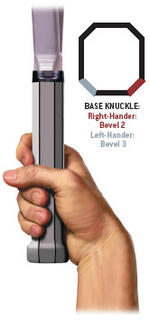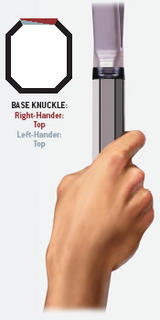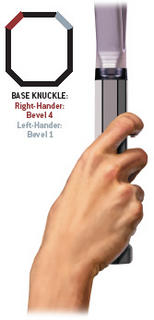Gr-r-i-p Guide
by Jon Levey Apr 01 '05
taken from tennis.com
Fluid, powerful, and accurate strokes are the combination of many factors. But it all starts with how you hold the racquet.
No matter how much time you spend finding the perfect frame to beef up your game, the most important part of your racquet just might be your grip--not what the handle is made of, but how you hold it. Although they're largely overlooked, grips are the foundation of all the strokes in tennis. Where you position your hand on the eight-sided handle has a huge impact on each ball you hit. Your grip affects the angle of the racquet face, where you make contact, and ultimately the pace, spin, and placement of your shot.
The difficulty with grips is choosing the right one for a particular stroke. The fact is, there is no perfect grip; each has its advantages and limitations. But some are clearly better-suited for certain strokes and styles of play than others. This guide will help you to (1) learn to grasp the racquet for each grip correctly, and (2) determine the best uses of each of the common grips.
Finding the Grips
There are various ways to explain how to find a certain grip, but the simplest and most reliable is to use the base knuckle of your index finger as the main reference point. The diagrams for each grip show the bottom view of a racquet handle (where the butt cap is attached), which has four main sides and four narrower bevels between the sides.
Continental Grip
The Continental is the one grip that you can use for every shot, but that hasn't been standard practice since the days of long pants and skirts. The Continental is used primarily for serves, volleys, overheads, slices, and defensive shots. Find the Continental by putting the base knuckle of your index finger on bevel No. 1, which puts the V created by your thumb and forefinger on top of the handle. Lefties put the knuckle on bevel No. 4.
Plus :
Hitting with the Continental grip on the serve and overhead is standard, as it allows your forearm and wrist to naturally pronate through contact. This results in a more explosive and versatile shot with the least amount of stress on the arm. It's also the preferred grip on volleys since it provides a slightly open racquet face for underspin and control. Since you need quick hands at net, having the same grip for forehand and backhand volleys is also crucial. As mentioned, your grip affects the angle of the racquet face. The more closed the face, the higher and farther in front of your body your strike zone should be for proper contact. Since the racquet face is relatively square on a Continental grip, for ground strokes the strike zone is low and to the side of the body. That's why it's helpful for defensive shots, low balls, and wide balls that you're late on.
Minus :
You can hit flat or with slice using the Continental, but it's tough to put topspin on the ball. That means hitting with power and keeping the ball in play requires you to aim the shot just above net level, leaving you little margin for error. And without that safety spin, returning a ball out of your strike zone can be difficult. So lack of consistency is often a problem.
Pros who use it : Virtually all of them, on serves and volleys.
Eastern Forehand Grip
Place your hand flat against the strings and slide it down to the grip; put the racquet flat on a table, close your eyes, and pick it up; or shake hands with the racquet. These are just a few of the tricks you can use to find an Eastern forehand grip. The more technical way is to hold the racquet in a Continental grip and then turn your hand clockwise (counterclockwise for lefties), so that the base knuckle of your index finger slides over one bevel.
Plus :
This is generally considered the easiest grip for learning the forehand. It's versatile, allowing the player to brush up the back of the ball for topspin or flatten out the shot for more power and penetration. It's easy to switch quickly to other grips from the Eastern, making it a wise choice for players who like to come to net.
Minus :
The strike zone is higher and farther out in front than with the Continental grip, but it's still not a great option for returning high shots. An Eastern forehand can be very powerful and penetrating, but because it tends to be a flatter stroke it can also be inconsistent, making it difficult to sustain in long rallies. It's not the best choice for players looking to put a lot of topspin on their shots and outlast their opponents.
Pros who use it: Tim Henman, Lindsay Davenport
Western Forehand Grip
From a semi-Western grip, shift your knuckle one more bevel clockwise (counterclockwise for lefties), and you've got a full Western grip. Looking down at the racquet, your knuckle should be on the very bottom of the grip. This puts your palm almost completely under the racquet. Clay-court specialists and players who hit with heavy topspin favor this grip.
Plus :
This is an extreme grip that puts a lot of action on the ball. The positioning of the wrist forces the racquet to whip up the back of the ball severely, generating tremendous topspin. You can hit the ball well above net level and it will still drop into the court. The resulting shot will usually have a high and explosive bounce, pushing your opponent behind the baseline. The strike zone is higher and farther out in front than all other forehand grips. The ability to handle high balls is what makes this grip so popular with clay-courters and juniors.
Minus :
Low balls can be murder. That's why professionals with this grip generally don't do well on faster surfaces, where the ball stays low after the bounce. Also, you need tremendous racquet-head speed and wrist strength to generate adequate pace and spin. Otherwise, your shots will land short and your opponents can attack them. For some, it's also difficult to flatten shots out, so putting balls away becomes a problem. And just as with the semi-Western, transitioning to net and hitting an effective first volley is a major challenge.
Pros who use it: Rafael Nadal, Amelie Mauresmo
Semi-Western Forehand
 Grip Moving your knuckle one more bevel clockwise (counterclockwise for lefties) from the Eastern forehand grip puts you in a semi-Western grip. This has become a prevalent grip for power baseliners on the pro tours, and many teaching pros encourage their students to use it. Plus :
Grip Moving your knuckle one more bevel clockwise (counterclockwise for lefties) from the Eastern forehand grip puts you in a semi-Western grip. This has become a prevalent grip for power baseliners on the pro tours, and many teaching pros encourage their students to use it. Plus :The semi-Western allows a player to apply more topspin to the ball than the Eastern forehand grip, giving the shot greater safety and control, especially on lobs and short angles. Still, you can drive through the ball with this grip to hit a flat drive for a winner or passing shot. It also affords a player the option of taking a bigger swing at the ball since the topspin will help keep it in the court. With a strike zone higher and farther out in front of the body than the Eastern forehand, it's good for controlling and being aggressive with high shots.
Minus :
You can run into trouble returning low balls. Since the grip naturally closes the racquet face, forcing you to swing up from underneath the ball, it can be difficult to return lower shots. This, along with having to make a significant grip change to get to the Continental for a volley, is why so many power baseliners are uncomfortable coming to net.
Pros who use it : Marat Safin, Svetlana Kuznetsova
Eastern Backhand Grip
 From a Continental grip, shift your knuckle one bevel counterclockwise (clockwise for lefties) so that it's on the very top of the grip. If you drilled a nail through that knuckle, it would go right through the center of the grip (just don't try that at home).
From a Continental grip, shift your knuckle one bevel counterclockwise (clockwise for lefties) so that it's on the very top of the grip. If you drilled a nail through that knuckle, it would go right through the center of the grip (just don't try that at home).Plus :
As with the Eastern forehand, this is a versatile grip that provides good stability for the wrist. You can roll the ball for some spin or hit through it for a more penetrating drive. Some players can slice with an Eastern grip, but if not, a subtle grip change over to the Continental is easy enough to do. This grip also can be used for a kick serve, and it makes the transition to net for volleys a relatively smooth one.
Minus :
While solid for handling low balls, an Eastern backhand grip is not ideal for hitting topspin shots from around the shoulders. It can be difficult to control these balls, and many times a player is forced to slice them back defensively. You see this most often when players return kick serves that jump up high in the strike zone.
Pros who use it : Roger Federer, Lisa Raymond
Extreme Eastern or Semi-Western Backhand Grip
 The backhand's answer to the Western forehand (a reason some refer to this as a semi-Western backhand), the base knuckle of your index finger moves one bevel counterclockwise from the Eastern backhand (clockwise for lefties). It's an advanced grip that only stronger and more accomplished players tend to use.
The backhand's answer to the Western forehand (a reason some refer to this as a semi-Western backhand), the base knuckle of your index finger moves one bevel counterclockwise from the Eastern backhand (clockwise for lefties). It's an advanced grip that only stronger and more accomplished players tend to use.Plus :
Just as with the Western forehand grips, this is a very popular choice with clay-court players. It naturally closes the racquet face more than a regular Eastern backhand and moves the strike zone higher and farther out in front of you, making it more conducive to handling high balls and returning them with topspin. Some of the most powerful backhands in tennis are held with this grip.
Minus :
Its limitations are similar to those of the Western forehand. It's not well-suited for low balls, and because it's a rather extreme grip it's difficult to make quick changes for a transition to net. Players with this grip usually have long, elaborate swings and prefer the baseline.
Pros who use it : Gustavo Kuerten, Justine Henin-Hardenne
Two-Handed Backhand Grip
 There's no doubting the popularity of this grip, but there is some debate about the ideal way to position both hands. One of the most accepted ways is to hold the racquet in your dominant hand with a Continental grip. Then take your nondominant hand and put it above your playing hand in a semi-Western forehand grip.
There's no doubting the popularity of this grip, but there is some debate about the ideal way to position both hands. One of the most accepted ways is to hold the racquet in your dominant hand with a Continental grip. Then take your nondominant hand and put it above your playing hand in a semi-Western forehand grip.Plus :
This is an excellent choice for players who aren't strong enough to hit a one-handed backhand. A more compact stroke than the one-hander, the two-hander relies on shoulder rotation and an efficient swing to provide power. That's why it's particularly effective on the return of serve. It's also good on low shots, and the extra arm lets you power through on balls that are at shoulder level.
Minus :
Because both hands are on the racquet, the two-hander limits a player's reach. So doing anything with wide shots can be tough, especially since it's difficult to rotate your upper body when stretched. Also, two-handers can become dependent on topspin. Hitting an effective slice calls for extending through the shot with a steady front shoulder. This is unnatural for two-handers, who are taught to open their hips and rotate their shoulders. Taking the nondominant hand off the racquet to hit the slice or volley is also troubling for many two-handers; it's the reason why they're generally not comfortable at the net.
Pros who use it : Andre Agassi, Maria Sharapova

